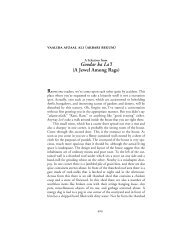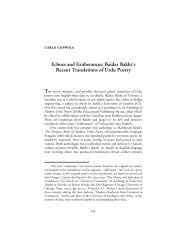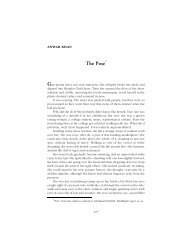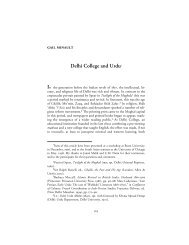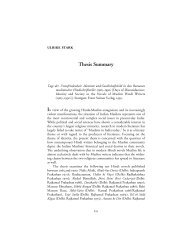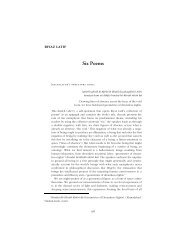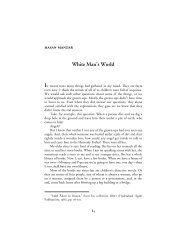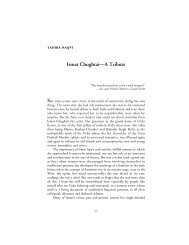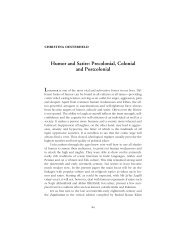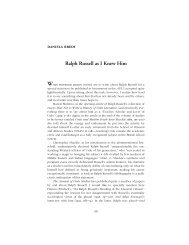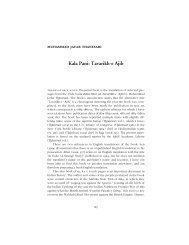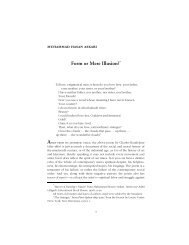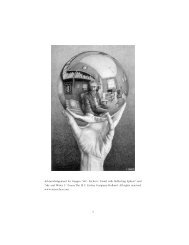Politics, Public Issues and the Promotion of Urdu Literature: Avadh ...
Politics, Public Issues and the Promotion of Urdu Literature: Avadh ...
Politics, Public Issues and the Promotion of Urdu Literature: Avadh ...
Create successful ePaper yourself
Turn your PDF publications into a flip-book with our unique Google optimized e-Paper software.
ULRIKE STARK<strong>Politics</strong>, <strong>Public</strong> <strong>Issues</strong> <strong>and</strong> <strong>the</strong><strong>Promotion</strong> <strong>of</strong> <strong>Urdu</strong> <strong>Literature</strong>:<strong>Avadh</strong> Akhbar, <strong>the</strong> First <strong>Urdu</strong> Daily inNor<strong>the</strong>rn IndiaLAUNCHED IN 1858 from <strong>the</strong> Naval Kishore Press in Lucknow, Avad^Akhb≥r was <strong>the</strong> most lucrative journalistic venture <strong>of</strong> <strong>the</strong> famed NorthIndian publisher <strong>and</strong> print capitalist Munshi Naval Kishore <strong>and</strong> a greatsuccess with <strong>the</strong> <strong>Urdu</strong> reading public. At a time when most <strong>Urdu</strong> paperswere short-lived, it remained in circulation up to <strong>the</strong> year 1950, itslifespan <strong>of</strong> almost a century covering a crucial period in <strong>the</strong> history <strong>of</strong>colonial India. In 1877 Avad^ Akhb≥r (hereafter AA) became <strong>the</strong> first <strong>Urdu</strong>daily in nor<strong>the</strong>rn India. It was to remain <strong>the</strong> only commercially viabledaily newspaper in <strong>Urdu</strong> for a whole decade, until its first serious rivalemerged in <strong>the</strong> form <strong>of</strong> <strong>the</strong> Paisa Akhb≥r (est. 1887) <strong>of</strong> Lahore, a paperemulating <strong>the</strong> concept <strong>of</strong> <strong>the</strong> British penny paper. 1 Exemplifying <strong>the</strong> earlyphase <strong>of</strong> commercialization in <strong>the</strong> <strong>Urdu</strong> newspaper trade, AA was readacross a wide geographical region ranging from Delhi to Haidarabad <strong>and</strong>from Lahore to Calcutta. This essay traces <strong>the</strong> history <strong>of</strong> <strong>the</strong> paper’s first1 According to Muhammad Sadiq, <strong>the</strong> Paisa Akhb≥r marked a turning pointin <strong>Urdu</strong> journalism <strong>and</strong> a dividing line between older <strong>and</strong> modern journalism inthat it initiated <strong>the</strong> differentiation between <strong>the</strong> literary journal <strong>and</strong> <strong>the</strong> newspaperas a mere purveyor <strong>of</strong> news. M. Sadiq, A History <strong>of</strong> <strong>Urdu</strong> <strong>Literature</strong>, 2nd ed.(Delhi: Oxford University Press, 1995), p. 616. In actual fact, <strong>the</strong> matter is hardlythat simple, for newspapers continued to include poetry <strong>and</strong> fictional writing in<strong>the</strong>ir columns. AA is a case in point. For <strong>the</strong> difficulties in providing a <strong>the</strong>oreticallyrigorous distinction between newspaper <strong>and</strong> literary magazine in <strong>the</strong> nineteenthcentury, see Graham Law, Serializing Fiction in <strong>the</strong> Victorian Press(Houndmills: Palgrave, 2000), p. xv.66
ULRIKE STARK • 67forty years, during which it made a distinct impact on <strong>the</strong> emerging <strong>Urdu</strong>public sphere. Outlining <strong>the</strong> growth, contents <strong>and</strong> policy <strong>of</strong> AA, it willlook at both economic <strong>and</strong> human factors in <strong>the</strong> making <strong>of</strong> an outst<strong>and</strong>ingpopular success in nineteenth-century <strong>Urdu</strong> journalism. 2Munshi Naval Kishore (1836–95) is one <strong>of</strong> several eminent Hindupublicists who figure prominently in <strong>the</strong> history <strong>of</strong> nineteenth-century<strong>Urdu</strong> journalism. Following his higher education at Agra College, hewent to Lahore to receive his training as a printer <strong>and</strong> journalist at <strong>the</strong>famous Kåh-e N∑r Press (est. 1849) <strong>of</strong> Munshi Harsukh R≥’® (1816–90),<strong>the</strong> doyen <strong>of</strong> <strong>Urdu</strong> journalism in <strong>the</strong> Punjab. 3 At <strong>the</strong> beginning <strong>of</strong> 1856Naval Kishore returned to Agra to establish his own <strong>Urdu</strong> weekly, Safµr-e¥gra. 4 His plans, however, were thwarted by political events. In September1857 we find him back in Lahore where he assumed <strong>the</strong> editorship <strong>of</strong>Kåh-e N∑r <strong>and</strong> successfully saw <strong>the</strong> paper through <strong>the</strong> uprising <strong>of</strong> 1857.His loyalty towards <strong>the</strong> British at <strong>the</strong> time would be amply rewardedwhen he moved on to Lucknow in 1858—he was <strong>the</strong> first Indian to begranted a license to operate a printing press in <strong>the</strong> city after <strong>the</strong> “Mutiny.”Established under <strong>the</strong> name <strong>of</strong> Maπba‘-e Avad^ Akhb≥r in 1858, <strong>the</strong> NavalKishore Press (hereafter NKP) rose to great fame in <strong>the</strong> history <strong>of</strong> commercial<strong>and</strong> scholarly publishing in India with an unparalleled range <strong>of</strong>publications in Arabic, Persian, Sanskrit, Hindi <strong>and</strong> <strong>Urdu</strong>.Compared to o<strong>the</strong>r North Indian urban centers, <strong>Urdu</strong> journalismstarted late in Lucknow. This was due to <strong>the</strong> particular circumstance that,following a temporary closure <strong>of</strong> all printing presses in <strong>the</strong> city by V≥jid‘Alµ Sh≥h in 1849, conditions <strong>of</strong> strict censorship prevailed in <strong>Avadh</strong>. Nosooner had <strong>the</strong> nav≥bµ come to an end through <strong>the</strong> British annexation <strong>of</strong><strong>Avadh</strong> in 1856 than at least seven <strong>Urdu</strong> weeklies were launched in2I am grateful to Christina Oesterheld for patiently assisting me in readingthrough <strong>the</strong> files <strong>of</strong> AA.3Munshi Harsukh R≥’®, a Kayastha from Sik<strong>and</strong>arabad, had earlier served aseditor to <strong>the</strong> J≥m-e Jamsh®d , an <strong>Urdu</strong> journal <strong>of</strong> Meerut. At <strong>the</strong> instigation <strong>of</strong> <strong>the</strong>British he moved to Lahore in 1849 where, with <strong>the</strong> support <strong>of</strong> <strong>the</strong> PunjabAdministration Board, he established his own press <strong>and</strong> launched <strong>the</strong> first <strong>Urdu</strong>newspaper in <strong>the</strong> Punjab. With a circulation <strong>of</strong> nearly 350 copies (1854) <strong>the</strong> Kåh-eN∑r remained for a long time <strong>the</strong> most influential <strong>Urdu</strong> paper in <strong>the</strong> province.Harsukh R≥’® subsequently rose to a position <strong>of</strong> prominence in Lahore society.4Safµr-e ¥gra, a weekly comprising twelve pages, was launched on 19 January1856. N≥dir ‘Alµ Kh≥n, Hindust≥nµ Pr®s, 1556–1900 (Lucknow: Uttar Pradesh <strong>Urdu</strong>Akademi, 1990), p. 286.
68 • THE ANNUAL OF URDU STUDIESLucknow within a year’s time. 5 The 1857 uprising, however, brought <strong>the</strong>city’s thriving print <strong>and</strong> publishing industry to a complete st<strong>and</strong>still. Thevacuum Naval Kishore encountered on his arrival in Lucknow in early1858 <strong>and</strong> <strong>the</strong> initial absence <strong>of</strong> local competition in <strong>the</strong> newspaper tradecertainly did much to enhance <strong>the</strong> early growth <strong>of</strong> AA. The paper’slasting <strong>and</strong> extraordinary success, however, must be attributed to anumber <strong>of</strong> o<strong>the</strong>r factors.The first factor was British patronage in <strong>the</strong> form <strong>of</strong> subscriptions<strong>and</strong> <strong>the</strong> overall support extended to <strong>the</strong> NKP. From <strong>the</strong> outset NavalKishore entered into an intense business collaboration with <strong>the</strong> colonialadministration, printing all kinds <strong>of</strong> government forms <strong>and</strong> registers. Henot only held a monopoly in textbook printing in <strong>Avadh</strong>, but subsequentlymanaged to get <strong>the</strong> lion’s share <strong>of</strong> <strong>of</strong>ficial patronage in <strong>the</strong> amalgamatedNorth-Western Provinces <strong>and</strong> <strong>Avadh</strong>: by 1882 over 75 percent <strong>of</strong>British printing commissions went to his press, <strong>the</strong> remainder beingshared by fifteen presses. 6 A large proportion <strong>of</strong> <strong>the</strong> pr<strong>of</strong>its made fromgovernment-job work was reinvested in Oriental book publishing <strong>and</strong>some went into sustaining AA. The government, in its turn, patronized<strong>the</strong> paper by subscribing to a number <strong>of</strong> copies which were distributed to<strong>the</strong> schools <strong>and</strong> colleges in <strong>the</strong> provinces. If <strong>of</strong>ficial statistics are a measureto go by, colonial patronage <strong>of</strong> <strong>the</strong> paper was not quite as substantial assome later voices made it out to be: With 50 out <strong>of</strong> 820 copies in 1877, 94out <strong>of</strong> 732 copies in 1886, <strong>and</strong> 94 out <strong>of</strong> 521 copies in 1895, governmentsubscriptions hardly ever exceeded twenty percent <strong>of</strong> <strong>the</strong> paper’s totalcirculation. 75 The most important was <strong>the</strong> ∫ilism-e Lak^na’∑, edited by MaulvµMu√ammad Ya‘q∑b <strong>of</strong> <strong>the</strong> Firangi Mahal family. Details in Nadir Ali Khan, AHistory <strong>of</strong> <strong>Urdu</strong> Journalism (Delhi: Idarah-i Adabiyat-i Delli, 1991), pp. 294–355.6 Proceedings <strong>of</strong> <strong>the</strong> Government NWP & Oudh, General Dept., May 1886, p.16.7 The circulation <strong>of</strong> AA during <strong>the</strong> nineteenth century never exceeded 850copies. It has to be borne in mind, however, that circulation figures at no timereflect actual readership. Newspapers like AA were widely recirculated <strong>and</strong> frequentlyread out to groups <strong>of</strong> non-literate people in both private homes <strong>and</strong>public arenas. See my paper “Lucknows Jalsa-i Tahzib: Urbane Elite, organisierteH<strong>and</strong>lungskompetenz und frühe ‘associational culture’ in Britisch-Indien,” inH<strong>and</strong>eln und Verh<strong>and</strong>eln. Kolonialismus, Transkulturelle Prozesse und H<strong>and</strong>lungskompetenz,ed. Harald Fischer-Tiné (Muenster: LIT, 2002), pp. 69–70; <strong>and</strong> also
ULRIKE STARK • 69The second success factor concerned <strong>the</strong> pr<strong>of</strong>essional management <strong>of</strong><strong>the</strong> paper. AA was one <strong>of</strong> <strong>the</strong> first <strong>Urdu</strong> papers to be run along soundcommercial lines. This implied that <strong>the</strong> paper partly financed itselfthrough advertisements. Compared to British newspapers at <strong>the</strong> time,which made larger incomes from advertising than from sales, 8 <strong>the</strong> proportion<strong>of</strong> space given to advertisements was relatively small. A typical issue<strong>of</strong> AA in 1871, for example, comprised sixteen pages <strong>of</strong> which an average<strong>of</strong> four would be given to advertising. Subsequently advertising came toaccount for an increasingly important part <strong>of</strong> <strong>the</strong> paper’s revenue. In 1879,<strong>the</strong> rate obtaining for occasional small advertisements was 2 annas per line<strong>and</strong> column. Rates for regular commercial advertisements depended onhow <strong>of</strong>ten an ad was placed in <strong>the</strong> paper <strong>and</strong> ranged from Rs. 12 forinsertion once a month to Rs. 60 for insertion six times a month. 9 By thattime AA carried regular advertisements for br<strong>and</strong>ed goods <strong>and</strong> for patentmedicines such as <strong>the</strong> widely advertised Holloway’s pills <strong>and</strong> ointments or<strong>the</strong> “celebrated medicines” <strong>of</strong> one Dr. De Roos, <strong>of</strong> which <strong>the</strong> publishinghouse acted as a sole distributor. Local firms such as Murray & Co., alarge retail company selling wine <strong>and</strong> general merch<strong>and</strong>ise, <strong>and</strong> <strong>the</strong>Shaikh Haji Muhammad Bakhsh Company, a contractor <strong>of</strong> tents <strong>and</strong>uniforms, started to place regular full-page ads in <strong>the</strong> paper. The NKP, <strong>of</strong>course, also used <strong>the</strong> paper as a cheap medium to extensively advertise <strong>and</strong>invite subscriptions for its own book publications. In <strong>the</strong> early days <strong>of</strong>AA, announcements <strong>of</strong> important publications such as Gh≥lib’s PersianKulliy≥t or his Q≥πi‘-e Burh≥n would feature prominently on its front page(AA <strong>of</strong> 1 January 1862). Later, such notices were relegated to <strong>the</strong> interioror back <strong>of</strong> <strong>the</strong> paper but still appeared so frequently that <strong>the</strong> Delhi-basedNuΩratu ’l-Akhb≥r was prompted in 1876 to accuse AA <strong>of</strong> being totally“self-interested”: “The editor has been instructed not to write any articlebeneficial to <strong>the</strong> public, but only to print reviews <strong>of</strong> <strong>the</strong> books [publishedby] <strong>the</strong> press.” 10Sanjay Joshi, Fractured Modernity: Making <strong>of</strong> a Middle Class in Colonial NorthIndia (Oxford: Oxford University Press, 2001), pp. 38–9.8 Lucy Brown, Victorian News <strong>and</strong> Newspapers (Oxford: Clarendon Press,1985), p. 16.9 See Fihrist-e Kutub-e Maπba‘-e Munshµ Navalkishår (Lucknow: Naval KishorePress, 1879), p. 4.10NuΩratu ’l-Akhb≥r <strong>of</strong> 1 August 1876; quoted in Imd≥d ¿≥birµ, T≥rµkh-e¿a√≥fat-e Urd∑, vol. 2 (Delhi: Jadµd Printing Press, 1953), pp. 97–8.
70 • THE ANNUAL OF URDU STUDIESThe third factor, to be discussed later, was <strong>the</strong> group <strong>of</strong> people wholed <strong>the</strong> paper. AA had <strong>the</strong> distinction <strong>of</strong> being headed by a number <strong>of</strong>eminent editors who were scholars, poets or prose writers in <strong>the</strong>ir ownright. This latter circumstance also accounts for <strong>the</strong> paper’s influentialrole in <strong>the</strong> promotion <strong>of</strong> modern <strong>Urdu</strong> literature for, in <strong>the</strong> typical fashion<strong>of</strong> early <strong>Urdu</strong> papers, AA combined <strong>the</strong> functions <strong>of</strong> newspaper <strong>and</strong>literary journal. It promoted both poetry <strong>and</strong> prose writing <strong>and</strong> evolvedinto a forum for literary debate, attracting <strong>the</strong> contributions <strong>of</strong> eminent<strong>Urdu</strong> literati <strong>of</strong> <strong>the</strong> day. The press <strong>of</strong>fice <strong>of</strong> AA, <strong>the</strong>n, was not only a placewhere information was generated, it was also a meeting point for <strong>the</strong><strong>Urdu</strong> literary scene.From Weekly to Daily: Growth <strong>and</strong> Development <strong>of</strong> <strong>Avadh</strong> AkhbarWhe<strong>the</strong>r it’s because <strong>the</strong> study <strong>of</strong> a commercially produced newspaperdoes not fall within <strong>the</strong> purview <strong>of</strong> modern scholars <strong>of</strong> <strong>Urdu</strong>, or perhapsbecause <strong>of</strong> <strong>the</strong> scarcity <strong>of</strong> extant early issues, 11 AA has received surprisinglylittle attention outside <strong>the</strong> st<strong>and</strong>ard works on <strong>Urdu</strong> journalism. In givinga brief overview <strong>of</strong> <strong>the</strong> paper’s growth <strong>and</strong> development, <strong>the</strong> followingparagraphs will try to fill some lacunae <strong>and</strong> also refute some inaccurateclaims concerning <strong>the</strong> paper’s format, frequency <strong>and</strong> editorship. As withmany early <strong>Urdu</strong> papers, <strong>the</strong>re is some disagreement over <strong>the</strong> date <strong>of</strong> firstpublication: While several authorities on <strong>Urdu</strong> journalism maintain that<strong>the</strong> first issue <strong>of</strong> AA did not appear before January 1859, <strong>the</strong> late Amµrƒasan N∑r≥nµ, himself an authority on <strong>the</strong> NKP, asserts that on <strong>the</strong> closure<strong>of</strong> <strong>the</strong> firm’s Kanpur press he chanced upon <strong>the</strong> first issue <strong>of</strong> <strong>the</strong>paper dating from 26 November 1858. Unfortunately <strong>the</strong> rare documentwas subsequently lent to a reputed <strong>Urdu</strong> scholar <strong>and</strong> could not beretrieved. 12 While <strong>the</strong>re is no reason to disbelieve N∑r≥nµ, later editorialnotices appearing in <strong>the</strong> paper contradict his information <strong>and</strong> support <strong>the</strong>11 The Khuda Bakhsh Oriental Library, Patna, holds issues <strong>of</strong> AA from 1866,1869, 1870–2, <strong>and</strong> 1875. The OIOC, London, has in stock almost complete runs<strong>of</strong> <strong>the</strong> paper between 1875 <strong>and</strong> 1884. According to Amµr ƒasan N∑r≥nµ, some filesfrom 1862 <strong>and</strong> 1870 are kept in <strong>the</strong> Aiv≥n-e Gh≥lib Library in Delhi.12Amµr ƒasan N∑r≥nµ, Sav≥ni√-e Munshµ Navalkishår (Patna: Khuda BakhshOriental <strong>Public</strong> Library, 1995), p. 136.
ULRIKE STARK • 711859 date. 13 Most importantly, <strong>the</strong> issue <strong>of</strong> 8 January 1862 was marked asvolume 4, no. 2, which clearly indicates <strong>the</strong> year 1859 for <strong>the</strong> first volume.This, however, does not altoge<strong>the</strong>r preclude <strong>the</strong> possibility that NavalKishore did indeed launch a first issue in 1858. Given <strong>the</strong> many tasks hehad to attend to on opening his press, he at first may not have been ableto publish his new paper on <strong>the</strong> intended regular weekly basis. Thiswould also explain why N∑r≥nµ maintains that AA was initially broughtout on a fortnightly basis. As things st<strong>and</strong>, regular weekly publication <strong>of</strong>AA only took <strong>of</strong>f a couple <strong>of</strong> weeks later, starting a fresh count with volumeone in January 1859.AA was initially a four-page weekly in <strong>the</strong> st<strong>and</strong>ard format <strong>of</strong> early<strong>Urdu</strong> papers, that is, 18 x 22 cm. Its frontispiece was adorned with adrawing <strong>of</strong> <strong>the</strong> Chattar Manzil <strong>and</strong> Farhat Bakhsh palace complex, evoking<strong>the</strong> erstwhile gr<strong>and</strong>eur <strong>of</strong> nav≥bµ Lucknow. It is worth noting that <strong>the</strong>frontispiece in its layout bears a striking resemblance to that <strong>of</strong> <strong>the</strong> IllustratedLondon News, one <strong>of</strong> <strong>the</strong> most popular Victorian weeklies at <strong>the</strong>time (Figures 1 <strong>and</strong> 2). Appearing each Wednesday, AA was well received<strong>and</strong> during <strong>the</strong> following years successfully competed against <strong>the</strong> rapidlygrowing number <strong>of</strong> <strong>Urdu</strong> papers. By 1864 its size had increased to sixteenpages. 14 Simultaneously, <strong>the</strong> format was enlarged to 22 x 29 cm. So overwhelmingwas <strong>the</strong> success <strong>of</strong> AA that on opening his printing press inKanpur in September 1865, Naval Kishore decided to bring out a localedition in <strong>the</strong> form <strong>of</strong> <strong>the</strong> K≥np∑r Gazaª. It was edited by Mu√ammadIsm≥‘µl, <strong>the</strong> manager <strong>of</strong> <strong>the</strong> firm’s Kanpur branch. Within <strong>the</strong> next twoyears, however, communication between Lucknow <strong>and</strong> Kanpur improvedto such an extent that <strong>the</strong> Kanpur edition was rendered superfluous.Accordingly, it was discontinued. 1513 AA <strong>of</strong> 22 December 1871, for instance, carried an editorial notice whichreferred to <strong>the</strong> paper’s lifespan with <strong>the</strong> words “This is <strong>the</strong> thirteenth year <strong>of</strong>God’s divine grace,” pointing to 1859. A similar notice in AA <strong>of</strong> 2 January 1874expressly stated that “In this factory in 1859 [a paper] called Avad^ Akhb≥r was putinto circulation.”14 J.H. Garcin de Tassy, La Langue et la Littérature Hindoustanies de 1850 à1869, 2nd ed. (Paris: Librairie de Maisonneuve et Cie, 1864–69), p. 245. TheFrench scholar’s claim that by 1867 <strong>the</strong> size <strong>of</strong> AA had fur<strong>the</strong>r increased to 24pages (ibid., 1867, p. 372) is inaccurate. The issues <strong>of</strong> 1871 still comprised no morethan 16 pages on average.15 Garcin de Tassy, 1867, p. 373.
72 • THE ANNUAL OF URDU STUDIESFigure 1Figure 2The next major step in <strong>the</strong> growth <strong>of</strong> AA illustrates <strong>the</strong> direct impact<strong>of</strong> government measures on <strong>the</strong> still volatile newspaper market. In 1871<strong>the</strong> st<strong>and</strong>ard postage for newspapers was reduced from one anna to halfan anna. With newspaper distribution depending almost entirely on <strong>the</strong>
ULRIKE STARK • 73colonial postal system, postage from <strong>the</strong> outset constituted a vital factor in<strong>the</strong> commercial history <strong>of</strong> “vernacular” papers. Nothing much hadchanged since 1822 when Harihar Dutt had solicited <strong>the</strong> government forfree postage, complaining that <strong>the</strong> circulation <strong>of</strong> his weekly J≥m-e Jah≥Num≥ had been “materially impeded <strong>and</strong> obstructed even in spite <strong>of</strong> mybest exertions <strong>and</strong> efforts to extend it.” This, Dutt maintained, was “inconsequence <strong>of</strong> its being liable to payment <strong>of</strong> full postage, which hasrestrained many intending subscribers in <strong>the</strong> m<strong>of</strong>ussil from patronising<strong>the</strong> said News Paper.” 16 The adverse effects <strong>of</strong> postage on circulation continuedto be a vexing problem for Indian newspaper proprietors. So muchso that in March 1869 Munshi Naval Kishore initiated a campaign for <strong>the</strong>reduction <strong>of</strong> postage for newspapers <strong>and</strong> periodicals <strong>and</strong> rallied a group <strong>of</strong>twenty-five influential newspaper proprietors <strong>and</strong> editors from all overNorth India, Calcutta <strong>and</strong> Bombay in drawing up a petition to <strong>the</strong> government.The petition at <strong>the</strong> time was rejected. 17 Yet <strong>the</strong> governmentseems to have had second thoughts, for in 1871 it introduced a fifty-percentreduction in <strong>the</strong> st<strong>and</strong>ard postage. Not surprisingly, <strong>the</strong> measuregave an immediate boost to <strong>the</strong> <strong>Urdu</strong> newspaper trade. It not only led to“a striking increase” 18 in <strong>the</strong> number <strong>of</strong> new launches, but also benefitedwell-established papers like AA which were able to attract larger numbers<strong>of</strong> subscribers. From August 1871 AA started to appear twice a week, <strong>and</strong>from May 1875 three times a week. Even after <strong>the</strong> reduction, postage continuedto account for a considerable proportion <strong>of</strong> readers’ expenses: In1877 <strong>the</strong> annual cost for ordinary subscribers was Rs. 20 excluding <strong>and</strong> Rs.30 including postage, postage thus comprising a third <strong>of</strong> <strong>the</strong> cost. Highersubscription rates <strong>of</strong> Rs. 40 <strong>and</strong> Rs. 50, respectively, obtained for <strong>the</strong>gentry <strong>and</strong> nobility. The provincial government at <strong>the</strong> time subscribed to50 copies charged at ordinary subscription rates—Naval Kishore’s attemptto introduce higher rates was rejected outright.AA did much to enhance <strong>the</strong> spread <strong>of</strong> <strong>the</strong> newspaper reading habitamong <strong>the</strong> aristocracy <strong>and</strong> educated middle class in <strong>the</strong> North-WesternProvinces <strong>and</strong> <strong>Avadh</strong>. That <strong>the</strong> paper also enjoyed growing popularity16 Quoted in P. Thankappan Nair, "Origin <strong>of</strong> <strong>the</strong> Persian, <strong>Urdu</strong> <strong>and</strong> HindiPrinting <strong>and</strong> Press in Calcutta," Indo-Iranica 43 (1990), p. 35.17 See Stark, pp. 67–8.18 Oudh Administration Report for <strong>the</strong> Year 1871–2, p. 128. ‘Abdu ’s-Sal≥mKhurshµd, ¿a√≥fat P≥kist≥n va Hind M® (Lahore: Majlis-e Taraqqµ-e Adab, 1963),p. 180.
74 • THE ANNUAL OF URDU STUDIESamong those sections <strong>of</strong> society who could not afford to subscribe to anewspaper regularly is borne out by <strong>the</strong> quaint testimony <strong>of</strong> a correspondent<strong>of</strong> AA who, writing from Hoshangabad in 1874, complained <strong>of</strong> <strong>the</strong>common malpractice <strong>of</strong> <strong>the</strong> servants <strong>of</strong> <strong>the</strong> post <strong>of</strong>fice who were in <strong>the</strong>habit <strong>of</strong> opening <strong>the</strong> covers <strong>of</strong> <strong>the</strong> paper addressed to him. Not only did<strong>the</strong>y read it <strong>the</strong>mselves, <strong>the</strong>y circulated it among <strong>the</strong>ir friends, on whichaccount <strong>the</strong> paper reached him very late. 19 One eminent subscriber <strong>of</strong> AAwho publicly welcomed its expansion <strong>and</strong> growing influence was SirSayyid A√mad Kh≥n. In <strong>the</strong> opinion <strong>of</strong> <strong>the</strong> great Muslim reformer, MunshiNaval Kishore was to be credited with having popularized <strong>the</strong> notion<strong>of</strong> a news magazine <strong>and</strong> created widespread public awareness for modernconcepts <strong>of</strong> information among <strong>Urdu</strong>-speakers in <strong>the</strong> North-WesternProvinces <strong>and</strong> <strong>Avadh</strong>. 20 In an article published in his own reformist journal,Tahÿµbu ’l-Akhl≥q (est. 1870), Sir Sayyid expressed his hope to see AAexp<strong>and</strong> even fur<strong>the</strong>r:Avad^ Akhb≥r has been a very respected paper before <strong>and</strong> nothing can beadded to it now. We hope that our contemporary journalists will imitateAvad^ Akhb≥r, <strong>and</strong> as for Munshi Naval Kishore’s magnanimity—God’sblessings upon him—we hope that his paper will appear on a daily basis in<strong>the</strong> manner <strong>of</strong> <strong>the</strong> large renowned English newspapers. May God let it beso. 21The praise <strong>and</strong> good wishes were mutual for AA openly sympathizedwith Islamic modernism <strong>and</strong> <strong>the</strong> Aligarh Movement. It did its best tosupport Tahÿµbu ’l-Akhl≥q when soon after its inception <strong>the</strong> paper facedsevere opposition from <strong>the</strong> Muslim orthodoxy. The editor <strong>of</strong> AA at <strong>the</strong>time was Ghul≥m Mu√ammad Kh≥n “Tapish,” a long-st<strong>and</strong>ing supporter<strong>of</strong> Sir Sayyid. He not only reprinted many <strong>of</strong> <strong>the</strong> articles published inTahÿµbu ’l-Akhl≥q, 22 but also adopted a policy <strong>of</strong> refusing to include in <strong>the</strong>19 AA <strong>of</strong> 16 October 1874, Selections from <strong>the</strong> Vernacular Newspapers Publishedin <strong>the</strong> Punjab, North Western-Provinces, Oudh <strong>and</strong> Central Provinces (SVN), 1874,p. 493.20 Syed Jalaluddin Haidar, “Munshi Nawal Kishore (1836–1895)(Mirror <strong>of</strong><strong>Urdu</strong> Printing in British India),” Pakistan Library Bulletin, Vol. XII, No. 1, p. 20.21 My translation. Tahÿµbu ’l-Akhl≥q, 1 Jam≥dµu ’¡-¬≥nµ 1288 A.H., quoted inKhurshµd, pp. 180–1.22 For example, Sir Sayyid’s influential review <strong>of</strong> William Hunter’s TheIndian Musalmans was reprinted in <strong>the</strong> AA <strong>of</strong> 22 December 1871.
76 • THE ANNUAL OF URDU STUDIESBah≥dur <strong>of</strong> Tonk, who had promised a yearly subscription <strong>of</strong> Rs. 100 insupport <strong>of</strong> <strong>the</strong> venture, <strong>the</strong> paper hoped that o<strong>the</strong>r members <strong>of</strong> <strong>the</strong> localaristocracy <strong>and</strong> affluent class <strong>of</strong> ra’µses would follow suit (AA <strong>of</strong> 25 May1877).That AA could continue as a regular daily even after <strong>the</strong> six-monthtrial period is inextricably linked to <strong>the</strong> specific historic context, notably<strong>the</strong> urgent need for news that <strong>the</strong> Turko-Russian War (1877–78) <strong>and</strong> <strong>the</strong>Second Anglo-Afghan War (1878–80) were creating among North Indians,particularly among Muslims. 25 The paper provided extensive coverage<strong>of</strong> <strong>the</strong> wars. In <strong>the</strong> process, it introduced new features such as a specialcolumn entitled “sar√ad/maid≥n-e jag kµ t≥zatarµn khabr®” (Latest NewsFrom <strong>the</strong> Frontier/Battlefield) <strong>and</strong> inserted maps <strong>and</strong> illustrations. It isinteresting to note that even though AA was never an illustrated newspaper,<strong>the</strong> visual element became increasingly important in its coverageespecially <strong>of</strong> foreign news. Readers were, among o<strong>the</strong>rs, regaled with largedrawings <strong>of</strong> <strong>the</strong> Paris International Exhibition <strong>of</strong> 1878 (AA <strong>of</strong> 1 October1878), <strong>of</strong> scenes from a Kabul war camp (AA <strong>of</strong> 28 February 1879), <strong>and</strong> <strong>of</strong>a Zulu warrior chief (AA <strong>of</strong> 31 May 1879).The publication <strong>of</strong> AA on a daily basis was also sustained by a second,altoge<strong>the</strong>r different factor. Following <strong>the</strong> assumption <strong>of</strong> <strong>the</strong> editorship byPan≈it Ratan N≥t^ “Sarsh≥r” in August 1878, installment publication <strong>of</strong> hisfamous <strong>Urdu</strong> novel Fas≥na-e ¥z≥d was started. This in fact was <strong>the</strong> firsttime that serialized fiction was successfully introduced in an <strong>Urdu</strong> newspaper.A l<strong>and</strong>mark in <strong>the</strong> history <strong>of</strong> modern <strong>Urdu</strong> fiction, Fas≥na-e ¥z≥dmet with an unprecedented public interest which gave a great boost to <strong>the</strong>paper. 26 The survival <strong>of</strong> AA as a daily <strong>the</strong>n rested on a combination <strong>of</strong>contemporary politics <strong>and</strong> modern prose fiction. Information <strong>and</strong> entertainmentas <strong>the</strong> two sustaining factors can hardly be dissociated from oneano<strong>the</strong>r for Sarsh≥r cleverly incorporated current political affairs into hisfictional narrative: Readers <strong>of</strong> Fas≥na-e ¥z≥d were made day-to-day witnesses<strong>of</strong> <strong>the</strong> hero ¥z≥d’s journey to Europe <strong>and</strong> his brave exploits infighting <strong>the</strong> Russians on <strong>the</strong> side <strong>of</strong> his Turkish fellow-Muslims.25 For a similar increase in sales <strong>of</strong> British daily newspapers provoked by <strong>the</strong>Turkish crisis, see Brown, p. 40.26 This was ra<strong>the</strong>r late as compared to Britain where serial fiction was by nomeans an invention <strong>of</strong> <strong>the</strong> Victorian era but dates back to <strong>the</strong> eighteenth century.For <strong>the</strong> history <strong>of</strong> serialized fiction <strong>and</strong> installment publication in Britain, seeLaw.
ULRIKE STARK • 77Contents <strong>and</strong> PolicyAA was a product <strong>of</strong> <strong>the</strong> colonial experience in that it aimed at being amodern, pr<strong>of</strong>essional news magazine. It emulated British models, its coverageincluding local, national <strong>and</strong> international news. In <strong>the</strong> name <strong>of</strong>spreading information <strong>and</strong> enlightenment among <strong>the</strong> <strong>Urdu</strong> reading public,AA aimed high, aspiring to be nothing less than <strong>the</strong> North Indianequivalent <strong>of</strong> The Times <strong>of</strong> London (AA <strong>of</strong> 1 January 1879). The newssection made up <strong>the</strong> largest portion <strong>of</strong> <strong>the</strong> paper which prided itself inbeing able to cover “<strong>the</strong> whole world.”How was efficient news coverage achieved <strong>and</strong> what were <strong>the</strong> channels<strong>of</strong> information transfer? It was only three years prior to <strong>the</strong> inception<strong>of</strong> AA that <strong>the</strong> opening <strong>of</strong> <strong>the</strong> first telegraph lines in India had inducedradical changes in <strong>the</strong> dissemination <strong>of</strong> news on <strong>the</strong> Subcontinent. 27 Nomodern news agencies, however, were operating in India before <strong>the</strong> year1866 when Reuters started extending its services <strong>the</strong>re. 28 Reuters, at allevents, was too expensive at first for <strong>the</strong> majority <strong>of</strong> Indian editors tomake use <strong>of</strong> its services. To ensure a rapid <strong>and</strong> steady flow <strong>of</strong> information,Munshi Naval Kishore <strong>the</strong>refore relied on a more traditional system <strong>of</strong>information distribution <strong>and</strong> built up his own network <strong>of</strong> correspondentsposted in <strong>the</strong> major urban centers in India. Apparently <strong>the</strong>ir number waslegendary, as suggested by a contemporary saying to <strong>the</strong> effect that inevery district <strong>and</strong> every princely state could be found correspondents <strong>of</strong><strong>the</strong> colonial government <strong>and</strong> <strong>of</strong> Munshi Naval Kishore. 29 A substantial27 The rapid development <strong>of</strong> <strong>the</strong> telegraph system has been summed up byDavid Arnold: “From a few miles <strong>of</strong> line in 1851, telegraphs had been extendedover 4,250 miles <strong>of</strong> India <strong>and</strong> linked forty-six receiving stations by <strong>the</strong> end <strong>of</strong>1856; <strong>the</strong>y ran from Calcutta to Agra <strong>and</strong> <strong>the</strong> northwest as well as connectingBombay, Madras <strong>and</strong> Ootacamund. By 1865 <strong>the</strong>re were 17,500 miles <strong>of</strong> telegraphlines, rising to 52,900 miles by <strong>the</strong> end <strong>of</strong> <strong>the</strong> century.” Science, Technology <strong>and</strong>Medicine in Colonial India (Cambridge: Cambridge University Press, 2000), p.113.28 Reuters set up its first <strong>of</strong>fice in Bombay in 1866. Fur<strong>the</strong>r <strong>of</strong>fices in Calcutta,Madras <strong>and</strong> Karachi followed, supplying <strong>the</strong> Indian press not only withforeign but also domestic information. The opening <strong>of</strong> <strong>the</strong> London-Bombaysubmarine telegraph cable in June 1870 greatly speeded up <strong>the</strong> transmission <strong>of</strong>news from Engl<strong>and</strong>. Details in Graham Storey, Reuters’ Century 1851–1951 (London:Max Parrish, 1951), pp. 62–8.29¿≥birµ, p. 112.
78 • THE ANNUAL OF URDU STUDIESportion <strong>of</strong> <strong>the</strong> domestic <strong>and</strong> foreign news was also reprinted from Englishnewspapers, particularly The Times <strong>of</strong> London, The Pioneer <strong>of</strong> Allahabad<strong>and</strong> <strong>the</strong> Friend <strong>of</strong> India. For news items regarding <strong>the</strong> Islamic world AAfrequently made use <strong>of</strong> Persian <strong>and</strong> Arabic newspapers. At <strong>the</strong> same time,generating news <strong>and</strong> information was turned into a public, collective concernin which <strong>the</strong> participation <strong>of</strong> <strong>the</strong> readership was explicitly invited:Those who would regularly supply <strong>the</strong> paper with “important, recent,reliable <strong>and</strong> interesting news items” 30 were promised free copies <strong>of</strong> AA inreturn.While introducing new concepts <strong>of</strong> modern informational culture,AA retained some features <strong>of</strong> <strong>the</strong> traditional newsletter as described byMichael H. Fisher. 31 For one, <strong>the</strong>re was <strong>the</strong> physical appearance <strong>of</strong> <strong>the</strong>h<strong>and</strong>written <strong>and</strong> lithographed sheets. The paper retained <strong>the</strong> term“akhb≥r≥t” for various categories <strong>of</strong> news; it adopted a Persianizedvocabulary <strong>and</strong> cultivated a fairly ornate style. Published in two parts, onWednesday <strong>and</strong> Friday, a typical issue <strong>of</strong> <strong>the</strong> paper in 1871 combined elements<strong>of</strong> traditional <strong>and</strong> modern newswriting in its st<strong>and</strong>ard departments.In <strong>the</strong> following overview <strong>of</strong> its contents <strong>the</strong> original <strong>Urdu</strong> has beenretained to show how this intermingling <strong>of</strong> <strong>the</strong> traditional <strong>and</strong> <strong>the</strong>modern was reflected in <strong>the</strong> vocabulary used to label <strong>the</strong> various headings:<strong>Avadh</strong> Akhbar in 1871Part One ([issued] on Wednesday) Part Two ([issued] on Friday)1) General advertisements1) Lucknow(ishtih≥r≥t ma‘m∑lµ)2) Poetry (na m) 2) Telegraph news (akhb≥r≥t tar-barqµ)3) Letters to <strong>the</strong> Editor (khaπ-kit≥bat) 3) Editorial (a≈µªåriyal)4) Proceedings <strong>of</strong> <strong>the</strong> Committee, 324) Correspondent (k≥rasp≥n≈anª)etc. (ma¤≥mµn kamiªµ vaghairah)5) Telegraph news (akhb≥r≥t t≥r-barqµ) 5) Translations from <strong>the</strong> English(tarjuma angr®zµ)6) Editorial (a≈µªåriyal) 6) Reprints from o<strong>the</strong>r papers (manq∑l≥t)7) Correspondent (k≥rasp≥n≈anª) 7) Letters to <strong>the</strong> Editor (khaπ-kit≥bat)30 Fihrist-e Kutub 1879, p. 4.31 Michael H. Fisher, “The Office <strong>of</strong> Akhb≥r Nawµs: The Transition fromMughal to British Forms,” Modern Asian Studies, Vol. 27, No. 1 (1993), pp.79–81.32 I.e., <strong>the</strong> Lucknow Municipal Committee.
8) Translations from English newspapers(tarjuma angr®zµ akhb≥r≥t)ULRIKE STARK • 798) Translations from <strong>the</strong>Government Gazette (tarjumagavarnmanª gazaª urd∑)9) Miscellanea (akhb≥r≥t mukhtalif) 9) Special notifications(ishtih≥r≥t ghair-ma‘m∑lµ)10) Local news/Lucknow(låkal akhb≥r≥t)By 1878 telegraph news had moved to <strong>the</strong> front part <strong>of</strong> <strong>the</strong> paper,whereas <strong>the</strong> advertisement <strong>and</strong> local news sections had been relegated to<strong>the</strong> back. This increased emphasis on rapid coverage <strong>of</strong> domestic <strong>and</strong>internal affairs, while immediately provoked by <strong>the</strong> wars, also formed part<strong>of</strong> a wider policy shift in which AA slowly moved away from older conventions<strong>of</strong> assembling <strong>and</strong> presenting news, towards a new kind <strong>of</strong> “efficient”<strong>and</strong> pr<strong>of</strong>essional journalism that was clearly based on Westernmodels.The local section <strong>of</strong> <strong>the</strong> paper was comparatively small. It providedinformation on current affairs in Lucknow. Next to news items on crimesor spectacular incidents, it included steady features such as <strong>the</strong> timetables<strong>of</strong> <strong>the</strong> Oudh Rohilkh<strong>and</strong> Railway (printed in <strong>Urdu</strong> <strong>and</strong> Devanagariscript), 33 legal notices, <strong>and</strong> <strong>the</strong> timings <strong>of</strong> court sessions. It also reportedon a wide array <strong>of</strong> cultural events, including mush≥‘iras, public lectures<strong>and</strong>, most importantly, <strong>the</strong> activities <strong>of</strong> local civic associations such as <strong>the</strong>Jalsa-e Tahÿµb or “Lucknow Reform Club” (est. 1868), <strong>of</strong> which NavalKishore was a prominent member. Among mush≥‘iras, those organized by<strong>the</strong> NKP <strong>and</strong> taking place regularly on its premises were given specialcoverage. Reports on <strong>the</strong>se ga<strong>the</strong>rings, which attracted both well-known<strong>and</strong> minor Lucknow poets, at times read like an inventory <strong>of</strong> local poetictalent. The AA <strong>of</strong> 1 January 1878, for example, carried <strong>the</strong> followingnotice:A special ga<strong>the</strong>ring <strong>of</strong> poets took place at <strong>the</strong> Avad^ Akhb≥r Press onMonday. The occasion was graced by eminent poets among <strong>the</strong> noblemen<strong>of</strong> Lucknow. The pattern-line was “sa± tå yeh hai hµ bur≥ håt≥ hai a±±^≥hån≥” (True it is, indeed, that being good is bad). But since, due to <strong>the</strong>lack <strong>of</strong> time, <strong>the</strong> distinguished poets had only been informed one day inadvance, <strong>the</strong>re were very few ghazals that conformed to <strong>the</strong> pattern-line.33 The railway timetable had become an integral part <strong>of</strong> suburban newspapercontent in London’s local papers since <strong>the</strong> 1840s. In introducing this feature <strong>the</strong>AA obviously acted on <strong>of</strong>ficial dem<strong>and</strong>.
ULRIKE STARK • 81this cautious stance could border on a kind <strong>of</strong> opportunism which wassuspicious even to British eyes. As an <strong>of</strong>ficial report noted in 1881:Of <strong>the</strong> Oudh papers <strong>the</strong> best is <strong>the</strong> Oudh Akhbar. This paper is, however,somewhat timid in tone, <strong>and</strong> rarely ventures to advocate strongly anyimportant measures till satisfied that <strong>the</strong>y are likely to find favor withGovernment. Though a consistent <strong>and</strong> admiring supporter <strong>of</strong> LordLytton’s various measures, no sooner did it hear <strong>of</strong> his resignation than ithastened to advocate those changes in policy which seemed likely wouldtake place under <strong>the</strong> new Government. 39Following <strong>the</strong> formation <strong>of</strong> <strong>the</strong> Indian National Congress in 1885, AAbecame a prime target for <strong>the</strong> nationalist <strong>Urdu</strong> press, particularly once itsproprietor Naval Kishore had openly joined ranks with Sir Sayyid A√madKh≥n’s United Indian Patriotic Association <strong>and</strong> assumed a leading positionin <strong>the</strong> anti-Congress movement. 40 It is difficult to dissociate politicalopposition from pr<strong>of</strong>essional rivalry in <strong>the</strong> bitter attacks on AA that various<strong>Urdu</strong> journals started to indulge in at that time. The continuouslylarge share <strong>of</strong> government patronage that Naval Kishore’s firm <strong>and</strong>, withit, AA enjoyed was indeed prone to incite jealousy. The rival <strong>Urdu</strong> pressinvariably portrayed Naval Kishore as a sycophant <strong>of</strong> <strong>the</strong> colonial empirewho in opposing <strong>the</strong> Congress was motivated by self-interest <strong>and</strong> servilityalone. In <strong>the</strong> process, AA was declared unable to represent national interests.Avad^ Pan± defamed <strong>the</strong> paper as a money-minded “bani≥ akhb≥r,”39 Report on <strong>the</strong> Administration <strong>of</strong> <strong>the</strong> North-Western Provinces <strong>and</strong> Oudh, for<strong>the</strong> year ending 31 March 1881, p. 359.40 There is a persisting myth, perpetuated in much biographical writing onNaval Kishore, that <strong>the</strong> publisher was a fervent supporter <strong>of</strong> <strong>the</strong> Indian NationalCongress <strong>and</strong> <strong>the</strong> Lucknow delegate to <strong>the</strong> inaugural session <strong>of</strong> <strong>the</strong> Congress heldin Bombay in 1885. This could not be fur<strong>the</strong>r from <strong>the</strong> truth. The Lucknow delegatewas Munshi Gag≥ Pras≥d Varm≥ (b. 1863), <strong>the</strong> proprietor-editor <strong>of</strong> <strong>the</strong>rivaling <strong>Urdu</strong> journal Hindust≥nµ <strong>and</strong> an outspoken adversary <strong>of</strong> Naval Kishore in<strong>the</strong> arenas <strong>of</strong> local journalism <strong>and</strong> politics. The confrontation <strong>of</strong> <strong>the</strong> two men wasstaged around <strong>the</strong> 1892 Municipal Elections in which Naval Kishore acted aschief canvasser for <strong>the</strong> anti-Congress c<strong>and</strong>idate B≥b∑ Shrµ R≥m, whereas Gag≥Pras≥d Varm≥ supported <strong>the</strong> Congress c<strong>and</strong>idate Pan≈it Bµshan Nar≥yan Dar. In1893 <strong>the</strong> two men clashed again over <strong>the</strong> election <strong>of</strong> <strong>the</strong> Lucknow delegate to <strong>the</strong>Provincial Legislative Council. Details in An<strong>and</strong> Shankar Singh, Growth <strong>of</strong> PoliticalAwakening in Uttar Pradesh, 1858–1900 (Varanasi: Vishwavidyalaya Prakashan,1991), pp. 144–6.
82 • THE ANNUAL OF URDU STUDIESwhile Hindust≥n accused it <strong>of</strong> consisting chiefly <strong>of</strong> “translations <strong>of</strong> articlesabusive <strong>of</strong> natives” taken from <strong>the</strong> Pioneer <strong>and</strong> <strong>the</strong> Civil <strong>and</strong> MilitaryGazette. 41 Gag≥ Pras≥d Varm≥’s Hindust≥nµ maintained that AA “blindlysupported government measures <strong>and</strong> proceedings in utter disregard <strong>of</strong> <strong>the</strong>interests <strong>of</strong> <strong>the</strong> people.” 42 AA in its turn claimed to have public opinionon its side <strong>and</strong> retorted that <strong>the</strong> public trusted <strong>the</strong> colonial governmentmore than it did <strong>the</strong> seditious Congress <strong>and</strong> its organs. In lashing out<strong>the</strong>ir polemics <strong>the</strong> pro-Congress papers deliberately overlooked <strong>the</strong> deepermotives <strong>of</strong> Naval Kishore’s opposition to <strong>the</strong> Congress. No doubt <strong>the</strong>publisher had to protect his commercial interests <strong>and</strong> was careful not toendanger business relations with his major customer by publishing anti-British propag<strong>and</strong>a in his paper, but to narrow his motivation down toeconomic dependence is certainly overstating <strong>the</strong> case. 43AA was not aloyalist paper by constraint but by choice. It firmly believed in <strong>the</strong> benefits<strong>of</strong> colonial rule. Yet loyalty <strong>and</strong> support <strong>of</strong> colonial rule, as understoodby <strong>the</strong> proprietor <strong>and</strong> editors <strong>of</strong> AA, did not automatically exclude acritique <strong>of</strong> government. True to its claim <strong>of</strong> representing public opinion,<strong>the</strong> paper was on occasion quite capable <strong>of</strong> articulating dissonant “native”views. C. A. Bayly has aptly described its stance as “covert criticism <strong>of</strong>British rule in Hindustan along <strong>the</strong> lines <strong>of</strong> old patriotism, but in <strong>the</strong>voice <strong>of</strong> unalloyed loyalism.” 44The coverage <strong>of</strong> <strong>the</strong> visit to Lucknow <strong>of</strong> <strong>the</strong> Prince <strong>of</strong> Wales in May1876 provides a characteristic example <strong>of</strong> this stance. The paper not onlypublished numerous poetical compositions in honor <strong>of</strong> <strong>the</strong> distinguishedvisitor but also, in its issue <strong>of</strong> 28 May 1876, contained a critical pieceunder <strong>the</strong> heading “Can <strong>the</strong> Indian Subjects be Content with <strong>the</strong> BritishGovernment?” which openly voiced its dissatisfaction with an administrationthat failed to cater to <strong>the</strong> basic needs <strong>of</strong> a populace assaulted by poverty<strong>and</strong> hunger. 45 In <strong>the</strong> issue <strong>of</strong> 6 March 1876 Munshi Naval Kishore,after a personal consultation with V≥jid ‘Alµ Sh≥h in Matia Burj, voicedhis protest against <strong>the</strong> treatment meted out to <strong>the</strong> former King <strong>of</strong> <strong>Avadh</strong>41 Quoted in Singh, pp. 25 <strong>and</strong> 65.42Hindust≥nµ <strong>of</strong> 6 July 1890, SVN 1890, p. 452.43 Ibid.44 C.A. Bayly, Origins <strong>of</strong> Nationality in South Asia: Patriotism <strong>and</strong> EthicalGovernment in <strong>the</strong> Making <strong>of</strong> Modern India (Delhi: Oxford University Press,1998), p. 91.45 Cf. Garcin de Tassy, 1876, pp. 8–12.
ULRIKE STARK • 83by <strong>the</strong> British. AA also liked to pose as a spokesman <strong>of</strong> <strong>the</strong> Indian-languagepress <strong>and</strong> frequently took up its cause in its columns. The issue <strong>of</strong>25 August 1874, for example, carried a complaint about <strong>the</strong> government’sdouble st<strong>and</strong>ards in dealing with <strong>the</strong> English <strong>and</strong> Indian-language press,stating that it was “extremely unjust that, while Government grantsspecial indulgences to editors <strong>of</strong> English newspapers, <strong>and</strong> exalts <strong>the</strong>m tohigh <strong>of</strong>fices in <strong>the</strong> public service, it should confer no such favors on <strong>the</strong>editors <strong>of</strong> vernacular newspapers.” 46 No doubt careful sifting <strong>of</strong> AA willproduce fur<strong>the</strong>r such examples. A content analysis <strong>and</strong> assessment <strong>of</strong> itssocio-political pr<strong>of</strong>ile <strong>and</strong> public impact remains to be undertaken.Against <strong>the</strong> backdrop <strong>of</strong> Munshi Naval Kishore’s active involvement innational politics, such an investigation will also have to address <strong>the</strong> intricatequestion as to what extent <strong>the</strong> political pr<strong>of</strong>ile <strong>of</strong> AA was shaped byits proprietor ra<strong>the</strong>r than its various editors. In any case, it should be <strong>of</strong>great interest to see how <strong>the</strong> leading <strong>Urdu</strong> daily <strong>of</strong> nor<strong>the</strong>rn India waswalking <strong>the</strong> tightrope between loyalty to <strong>the</strong> colonial government <strong>and</strong> <strong>the</strong>increasing exigencies <strong>of</strong> Indian nationalism.What can be safely said at this point is that from around 1890 <strong>the</strong> circulation<strong>of</strong> AA was in decline. By <strong>the</strong> turn <strong>of</strong> <strong>the</strong> century <strong>the</strong> paper hadlost much <strong>of</strong> its former appeal. According to B≥lmukund Gupta, <strong>the</strong>influential editor <strong>of</strong> <strong>the</strong> politically trenchant Hindi journal Bh≥ratmitra,this was due to <strong>the</strong> paper’s very refusal to engage in nationalist politics. Inresisting modernization <strong>and</strong> refusing to formulate its own distinct “policy,”<strong>the</strong> veteran journalist opined, AA had failed to keep up with <strong>the</strong> tide<strong>of</strong> <strong>the</strong> times. Moreover, despite <strong>the</strong> paper’s monetary resources <strong>and</strong> itsexcellent staff, <strong>the</strong> selection <strong>of</strong> English news items was “nonsensical,” <strong>and</strong><strong>the</strong>ir translations into <strong>Urdu</strong> “barely intelligible.” Writing in 1905, Guptaconcluded: “[AA] is exactly <strong>the</strong> same as it was twenty years ago <strong>and</strong> forthis very reason it has not established a reputation for itself in <strong>the</strong> newspaperworld during <strong>the</strong>se past twenty years. Most newspaper readerswon’t even know its name.” 47 To this critical observer at <strong>the</strong> beginning <strong>of</strong><strong>the</strong> new century AA no longer met <strong>the</strong> needs <strong>of</strong> modern journalism, buthad become a “lakir ka faqir” (“lakµr k≥ faqµr”) <strong>and</strong> a “besund ka hathi”(“b®-s∑n≈ k≥ h≥t^µ”).46 SVN 1874, p. 355.47 My translation. B≥lmukund Gupta, Gupta-Nib<strong>and</strong>h≥valµ, eds. JhabarmalSharm≥ <strong>and</strong> Ban≥rsµd≥s ≤aturvedµ (Delhi: Gaurav G≥th≥ Sagam, 1994), pp.262–3.
84 • THE ANNUAL OF URDU STUDIESPromoting <strong>Urdu</strong> <strong>Literature</strong>: Editors <strong>and</strong> ContributorsThe self-proclaimed aim <strong>of</strong> AA was to work towards <strong>the</strong> progress <strong>and</strong> welfare<strong>of</strong> India by informing <strong>and</strong> educating <strong>the</strong> Indian public through abroad news coverage. Yet at <strong>the</strong> same time <strong>the</strong> paper also assumed <strong>the</strong>function <strong>of</strong> a literary journal. It promoted both poetry <strong>and</strong> prose writing,covered literary events, announced new publications <strong>and</strong> provided aforum for literary debate. While <strong>the</strong> paper attracted <strong>the</strong> contributions <strong>of</strong>some leading <strong>Urdu</strong> literati from outside Lucknow, its role in <strong>the</strong> promotion<strong>of</strong> <strong>Urdu</strong> literature <strong>and</strong> <strong>the</strong> development <strong>of</strong> a modern prose style goesspecifically to <strong>the</strong> credit <strong>of</strong> a number <strong>of</strong> eminent intellectuals among itseditors. According to ¿≥birµ, no o<strong>the</strong>r <strong>Urdu</strong> paper <strong>of</strong> <strong>the</strong> period boastedsuch an illustrious range <strong>of</strong> editors as AA. 48 While some <strong>of</strong> <strong>the</strong>m werealready well-known figures in <strong>the</strong> world <strong>of</strong> literature <strong>and</strong> learning when<strong>the</strong>y joined <strong>the</strong> paper, o<strong>the</strong>rs used AA as a stepping stone in <strong>the</strong>ir futurecareers as publicists <strong>and</strong> writers.Although we have a fair picture <strong>of</strong> <strong>the</strong> various personalities associatedwith <strong>the</strong> editorship <strong>of</strong> AA, to establish a definite chronology <strong>of</strong> <strong>the</strong> paper’seditors remains problematic. Since <strong>the</strong>re was no formal declaration <strong>of</strong> <strong>the</strong>editor on <strong>the</strong> front cover <strong>of</strong> AA <strong>and</strong> since, according to common practice,editorial pieces generally remained unsigned, <strong>the</strong>ir names can only begleaned from references within <strong>the</strong> paper (a difficult task given <strong>the</strong> scarcity<strong>of</strong> extant issues) or from secondary sources. With many contradictingstatements st<strong>and</strong>ing in <strong>the</strong> way, <strong>the</strong> following account can only betentative. 49Equally, given <strong>the</strong> scarcity <strong>of</strong> extant issues for <strong>the</strong> period1859–1875, for <strong>the</strong> time being we can only look at <strong>the</strong> kind <strong>of</strong> intellectualsthat AA was able to attract. To assess <strong>the</strong> nature <strong>and</strong> quality <strong>of</strong> <strong>the</strong>ir contribution<strong>and</strong> <strong>the</strong> way in which <strong>the</strong>ir writings helped to shape <strong>the</strong> distinctpr<strong>of</strong>ile <strong>of</strong> AA remains subject to <strong>the</strong> future availability <strong>of</strong> source material.The first issues <strong>of</strong> AA were almost certainly edited by Munshi NavalKishore himself. However, he was soon forced to delegate this time-consumingtask to o<strong>the</strong>rs. In 1859 Maulvµ H≥dµ ‘Alµ “Ashk” (d. 1865) wasappointed <strong>the</strong> first formal editor <strong>of</strong> AA. Born in a family <strong>of</strong> reputedscholars in <strong>the</strong> qaΩba <strong>of</strong> Bijnor, H≥dµ ‘Alµ “Ashk” had been educated at <strong>the</strong>48¿≥birµ, p. 59.49 The following paragraphs draw largely on ¿≥birµ <strong>and</strong> on Akbar ƒaidarµ,“Munshµ Navalkishår aur Avad^ Akhb≥r,” Nay≥ Daur, Vol. 35, Nos. 8–9 (1980), pp.20–47.
ULRIKE STARK • 85Lucknow Madrasa Ni ≥mµya before he went on to serve <strong>the</strong> Mu√ammadµPress <strong>of</strong> H≥jµ ƒarmain Sharµfain, one <strong>of</strong> <strong>the</strong> earliest <strong>and</strong> most famous privateprinting presses in nav≥bµ Lucknow. 50 Ashk was an eminent scholar<strong>of</strong> Arabic <strong>and</strong> Persian, a master calligrapher <strong>and</strong> a poet who excelled in<strong>the</strong> art <strong>of</strong> composing chronograms (t≥rµkh-gå’µ). He was a sh≥gird <strong>of</strong> Nav≥bFat√u ’d-Daula Mirz≥ Mu√ammad Ra¤≥ “Barq” in whose company hespent some time at <strong>the</strong> court in exile <strong>of</strong> V≥jid ‘Alµ Sh≥h in Matia Burj.Ashk joined <strong>the</strong> NKP in 1858 as a calligrapher, but on account <strong>of</strong> his vastexpertise was soon promoted to <strong>the</strong> double position <strong>of</strong> editor <strong>of</strong> AA <strong>and</strong>head pro<strong>of</strong>reader in <strong>the</strong> firm’s lithographic department. While editor <strong>of</strong>AA he prepared <strong>the</strong> edition <strong>of</strong> Gh≥lib’s collected Persian verse Kulliy≥t-eGh≥lib (Lucknow: NKP, 1863) <strong>and</strong> prepared <strong>the</strong> calligraphy <strong>of</strong> a widelyacclaimed large-letter edition <strong>of</strong> <strong>the</strong> Qur’≥n, published posthumously asQur’≥n Sharµf Jalµ Qalam (Lucknow: NKP, 1870). Due to his failing healthhe had to ab<strong>and</strong>on <strong>the</strong> editorship <strong>of</strong> AA in 1864.It is not clear who took over after him. According to Garcin de Tassy,Munshi Shiv Parsh≥d, <strong>the</strong> manager <strong>of</strong> <strong>the</strong> NKP, assumed <strong>the</strong> editorship in1864. The French scholar, however, may have confounded <strong>the</strong> tasks <strong>of</strong>press manager <strong>and</strong> editor. He certainly made a ra<strong>the</strong>r consequential mistakein confounding Shµv Parsh≥d with his namesake R≥j≥ Shivpras≥d <strong>of</strong>Benares, <strong>the</strong> eminent educationist <strong>and</strong> textbook author, who, ever since,has been erroneously associated with <strong>the</strong> editorship <strong>of</strong> AA. 51 Munshi ShivParsh≥d, whose background remains obscure but for his origin in a distinguishedLucknow family, had originally been hired as a calligrapher forAA. By 1862 he had become manager <strong>of</strong> <strong>the</strong> NKP, a position in which heserved <strong>the</strong> publishing house until his death in <strong>the</strong> late 1890s. Shiv Parsh≥dwas a poet <strong>of</strong> <strong>Urdu</strong> who adopted <strong>the</strong> takhalluΩ “Wahbµ” <strong>and</strong> has a Kulliy≥teWahbµ (Lucknow: NKP, 1880) to his credit. Specimens <strong>of</strong> his versefrequently appeared in AA.According to an editorial notice published in a later issue <strong>of</strong> AA it wasMuftµ Fakhru ’d-Dµn A√mad “Fakhr” Lak^navµ (d. 1892) who took over<strong>the</strong> editorship from Maulvµ H≥dµ ‘Alµ in 1865. 52 The son <strong>of</strong> <strong>the</strong> reputed50 For an anecdote illustrating his superior skills as a calligrapher, see AbdulHalim Sharar, Lucknow: The Last Phase <strong>of</strong> an Oriental Culture, trans. E.S. Harcourt<strong>and</strong> Fakhir Husain (London: Paul Elek, 1975), p. 105–6.51 Cf. Garcin de Tassy, Histoire de la Littérature Hindouie et Hindustanies,vol. 3, 2nd ed., (Paris: Adolphe Labitte, 1871), pp. 268–73.52 AA <strong>of</strong> 2 January 1874, quoted in ¿≥birµ, p. 58.
86 • THE ANNUAL OF URDU STUDIESFirangi Mahal scholar Maul≥n≥ ◊afar A√mad, Fakhru ’d-Dµn had himselfbeen educated at Firangi Mahal <strong>and</strong> gained distinction for his remarkablerhetorical skills <strong>and</strong> his expertise in Islamic law. Like his predecessor,Fakhru ’d-Dµn, while serving as editor <strong>of</strong> AA, assisted <strong>the</strong> publishing housein various tasks, particularly as a pro<strong>of</strong>reader <strong>and</strong> translator <strong>of</strong> Persiantexts. At Naval Kishore’s instance he prepared <strong>the</strong> first <strong>Urdu</strong> translations<strong>of</strong> al-Ghazz≥lµ’s Kµmiy≥-e Sa‘≥dat <strong>and</strong> <strong>the</strong> Tafsµr-e ƒusainµ, a Qur’≥n commentaryby <strong>the</strong> fifteenth-century Persian moral philosopher ƒusain V≥‘µKh≥n. Written in fluid <strong>and</strong> lucid style, both texts were to assume specialimportance in <strong>the</strong> religious <strong>and</strong> moral instruction <strong>of</strong> Muslim women. 53Fakhru ’d-Dµn did not remain editor <strong>of</strong> AA for long. In 1866 he wassucceeded by Mu√ammad Mehdµ ƒusain Kh≥n, <strong>the</strong> ex-proprietor <strong>of</strong> <strong>the</strong>Riy≥¤-e N∑r Press (est. 1851) <strong>of</strong> Multan <strong>and</strong> former editor <strong>of</strong> an <strong>Urdu</strong>weekly <strong>of</strong> <strong>the</strong> same name. Apparently Mehdµ ƒusain Kh≥n had beenforced to close down his press in 1856, following a sentence <strong>of</strong> imprisonment<strong>of</strong> several years. He joined AA after his release from jail. 54In 1867 Mehdµ ƒusain Kh≥n in turn was succeeded by Maulvµ Raunaq‘Alµ (1846–76), a scholar <strong>and</strong> poet <strong>of</strong> Persian <strong>and</strong> <strong>Urdu</strong> who wrote under<strong>the</strong> pen names “Afs∑” <strong>and</strong> “Raunaq,” respectively. The son <strong>of</strong> a taluqdar<strong>of</strong> Barabanki district, Raunaq ‘Alµ had come to Lucknow in 1859 to receivehis higher education in Islamic learning. He was initially employed as apro<strong>of</strong>reader for AA but was soon promoted to <strong>the</strong> position <strong>of</strong> editor.Naval Kishore seems to have thought highly <strong>of</strong> him for in 1870 he senthim to Patiala to oversee <strong>the</strong> establishment <strong>of</strong> a new printing press in <strong>the</strong>princely state. From <strong>the</strong>re Raunaq ‘Alµ launched <strong>the</strong> Pati≥la Akhb≥r in53Published as Iksµr-e Hid≥yat (Kanpur: NKP, 1866), <strong>the</strong> translation <strong>of</strong>Kµmiy≥-e Sa‘≥dat was to figure among <strong>the</strong> books recommended especially forwomen in <strong>the</strong> st<strong>and</strong>ard works on Muslim female education, i.e., Alπ≥f ƒusainƒ≥lµ’s Maj≥lisu ’n-Nis≥’ <strong>and</strong> Ashraf ‘Alµ T^≥navµ´s Bihishtµ Z®var. The <strong>Urdu</strong>version <strong>of</strong> <strong>the</strong> Tafsµr ƒusainµ, entitled Tafsµr-e Q≥dirµ (Lucknow: NKP, 1879–80)headed <strong>the</strong> list <strong>of</strong> books that T^≥navµ deemed suitable for women. Details in GailMinault, Secluded Scholars: Women’s Education <strong>and</strong> Muslim Social Reform inColonial India (Delhi: Oxford University Press, 1998), p. 46 <strong>and</strong> Barbara D.Metcalf, Perfecting Women: Maulana Ashraf Thanawi’s Bihishti Zewar (Berkeley:University <strong>of</strong> California Press, 1990), pp. 376–8.54 AA <strong>of</strong> 2 January 1874, cited in ¿≥birµ, pp. 58–9. For Riy≥¤-e N∑r, see alsoKh≥n 1991, pp. 259–65; <strong>and</strong> Khurshµd, p. 123.
ULRIKE STARK • 87October 1871 at <strong>the</strong> request <strong>of</strong> <strong>the</strong> Maharaja <strong>of</strong> Patiala. He died in 1876 at<strong>the</strong> early age <strong>of</strong> thirty. 55A new era dawned for AA when, in 1870, Maulvµ Ghul≥m Mu√ammadKh≥n (d. 1904) assumed <strong>the</strong> editorship <strong>of</strong> <strong>the</strong> paper. A native <strong>of</strong> Delhi, hehad spent part <strong>of</strong> his youth in <strong>the</strong> company <strong>of</strong> <strong>the</strong> Nawab <strong>of</strong> Patauri <strong>and</strong>subsequently gained experience as a journalist <strong>and</strong> editor in Meerut <strong>and</strong>o<strong>the</strong>r places. Ghul≥m Mu√ammad Kh≥n was a pupil <strong>of</strong> Mirz≥ Gh≥lib <strong>and</strong>composed poetry in Persian <strong>and</strong> <strong>Urdu</strong> under <strong>the</strong> pen name “Tapish.”During <strong>the</strong> eight years <strong>of</strong> his editorship AA thrived. 56 Relations betweenhim <strong>and</strong> Munshi Naval Kishore, which for <strong>the</strong> longest time had beenamiable, took a dramatic turn in 1876, when, after a supposedly seriousaltercation between <strong>the</strong> two men, Ghul≥m Mu√ammad Kh≥n was dismissed.What prompted <strong>the</strong> dispute is not known. It may have had to dowith Ghul≥m Mu√ammad Kh≥n’s editorial policy, notably his overt support<strong>of</strong> Sir Sayyid A√mad Kh≥n’s reformist paper Tahÿµbu ’l-Akhl≥q which,as noted earlier, caused Munshi Naval Kishore some embarrassment. Atall events, it was none o<strong>the</strong>r than Sir Sayyid who personally came to <strong>the</strong>editor’s rescue: in an article appearing in <strong>the</strong> Aligarh Institute Gazette <strong>of</strong>29 September 1876 he expressed his deep regret over Ghul≥mMu√ammad’s dismissal <strong>and</strong> pointed out that Naval Kishore had carelesslylet go <strong>of</strong> one <strong>of</strong> <strong>the</strong> most capable editors <strong>of</strong> his paper, to whom AA owedits entire success. 57The letter did not fail in its purpose: Ghul≥mMu√ammad was promptly reinstalled in his capacity as editor. Yet, he didnot remain with AA for much longer; several months later he decided toresign as editor <strong>and</strong> leave <strong>the</strong> paper for good. In May 1877 he informed<strong>the</strong> readers <strong>of</strong> AA that having devoted all his energy to <strong>the</strong> paper for <strong>the</strong>past eight years <strong>and</strong> having ruined his health <strong>and</strong> eyesight in <strong>the</strong> process,he was to quit AA <strong>and</strong> start his own paper Mushµr-e QaiΩar-e Hindinstead. 58There is a ra<strong>the</strong>r dubious claim, probably going back to Garcin deTassy, that, following Tapish, for a short period Maul≥n≥ Sayyid Amjad‘Alµ “Ashharµ” (b. 1851) took charge <strong>of</strong> <strong>the</strong> paper. 59 This claim is not sub-55 Garcin de Tassy, 1876, pp. 136–7.56 Apparently Munshµ Fid≥ ‘Alµ “‘Aish” was assistant editor at <strong>the</strong> time.N∑r≥nµ, p. 74.57 The article is reprinted in Khurshµd, p. 182.58 For Tapish, see ¿≥birµ, pp. 99–104.59 Ibid., pp. 104–6.
88 • THE ANNUAL OF URDU STUDIESstantiated by biographical accounts on Ashharµ. 60 Indeed, it would seemstrange that this distinguished scholar <strong>of</strong> Persian <strong>and</strong> Arabic should giveup his high administrative post in <strong>the</strong> state <strong>of</strong> Bhopal <strong>and</strong> move toLucknow. In January 1881 Ashharµ established his own printing pressAmjad al-Maπba‘ in Bhopal from where he launched <strong>the</strong> journal Dabµru ’l-Mulk. A prolific poet <strong>and</strong> writer, Ashharµ made an important contributionto historiographical <strong>and</strong> biographical literature in <strong>Urdu</strong>.Mention has already been made <strong>of</strong> <strong>the</strong> next <strong>and</strong> most famous editor<strong>of</strong> AA, Pan≈it Ratan N≥t^ “Sarsh≥r” (1846–1902). If AA must be creditedwith having “launched <strong>the</strong> career <strong>of</strong> one <strong>of</strong> <strong>the</strong> most important prose fictionwriters in <strong>Urdu</strong>,” 61 it was Sarsh≥r who, in turn, brought about <strong>the</strong>heyday <strong>of</strong> <strong>the</strong> paper’s fame. Born in a Kashmiri Brahmin family settled inLucknow, Sarsh≥r received his education at Canning College <strong>and</strong> latertook up employment as a school teacher. He had for some time contributedarticles to various journals, particularly to Sayyid Sajj≥d ƒusain’ssatirical journal Avad^ Pan± (est. 1877), when Naval Kishore appointedhim as editor <strong>of</strong> AA on 10 August 1878. Apparently, Sarsh≥r had beenintroduced to Naval Kishore by <strong>the</strong> Director <strong>of</strong> <strong>Public</strong> Instruction R. T.H. Griffith <strong>and</strong> employed with a view to counteracting <strong>the</strong> fierce attackson AA that Avad^ Pan± had started to indulge in at <strong>the</strong> time. 62 It comes asno surprise that Sarsh≥r’s change <strong>of</strong> sides did little to alleviate <strong>the</strong> tensionbetween <strong>the</strong> two papers. On <strong>the</strong> contrary, <strong>the</strong> publication <strong>of</strong> Fas≥na-e¥z≥d <strong>and</strong> <strong>the</strong> ensuing boost it gave to <strong>the</strong> circulation <strong>of</strong> AA provokedjealous attacks <strong>and</strong> bitter criticism from Avad^ Pan±. The result, accordingto Sadiq, was “an open war between <strong>the</strong> two papers, which, after a crescendo<strong>of</strong> abuse <strong>and</strong> whacking blows on both sides, resulted in an honourabletruce.” 63This is not quite accurate, for <strong>the</strong> attacks continuedthroughout <strong>the</strong> 1880s: In August 1880 <strong>the</strong> Avad^ Pan± accused AA <strong>of</strong> beingan anti-Muslim paper. In 1886, <strong>the</strong> serialized publication in AA <strong>of</strong>60 See, e.g., Salµm ƒ≥mµd Ri¤vµ, Urd∑ Adab kµ Taraqqµ M® Bhåp≥l k≥ ƒiΩΩa(Bhopal: Alavµ Press, 1965), pp. 174–6.61 C.M. Naim <strong>and</strong> Carla Petievich, “<strong>Urdu</strong> in Lucknow/Lucknow in <strong>Urdu</strong>,”in Lucknow: Memories <strong>of</strong> a City, ed. Violette Graff (Delhi: Oxford UniversityPress, 1997), p. 171.62 Firoze Mookerjee, Lucknow <strong>and</strong> <strong>the</strong> World <strong>of</strong> Sarshar (Karachi: Saad <strong>Public</strong>ations,1992), pp. 57–8; Ram Babu Saksena, A History <strong>of</strong> <strong>Urdu</strong> <strong>Literature</strong> (1927;New Delhi: Asian Educational Services, 1990), p. 325.63 Sadiq, p. 418.
ULRIKE STARK • 89Sarsh≥r’s novel Sair-e Kohs≥r, a titillating narrative about a young Nawab’sillicit affair with a low-caste woman, prompted Avad^ Pan± to publiclyurge <strong>the</strong> government to take legal action against Naval Kishore for publishinga “very obscene” novel in a paper delivered to countless schools in<strong>the</strong> province. 64Fas≥na-e ¥z≥d was published in installments in AA from 13 August1878 to January 1880. 65 It started out as a series <strong>of</strong> humorous sketches( ar≥fat), published in loose succession. With its vivid <strong>and</strong> humorous portrayal<strong>of</strong> contemporary social life in Lucknow, it took <strong>the</strong> reading publicby storm <strong>and</strong>, from January 1879, was published at daily intervals. WhileSarsh≥r’s claims to Fas≥na-e ¥z≥d being a “modern novel” remain controversial,66 its publishing pattern marked <strong>the</strong> breakthrough <strong>of</strong> a new narrativegenre in <strong>Urdu</strong>—<strong>the</strong> serialized novel. As <strong>the</strong> first piece <strong>of</strong> original fictionin <strong>Urdu</strong> written expressly for publication in a newspaper, Fas≥na-e¥z≥d broke new ground: For one, it was a text conceived in installments,dem<strong>and</strong>ing self-contained units which were sufficiently barbed with suspenseto hook <strong>the</strong> reader to <strong>the</strong> plot before he was relegated to <strong>the</strong> nextissue <strong>of</strong> <strong>the</strong> paper by <strong>the</strong> inevitable “b≥qµ ≥’inda …” (“to be continued...”). Daily intervals imposed enormous pressure on <strong>the</strong> writer. The regulardoses <strong>of</strong> opium that Sarsh≥r was allegedly supplied with by <strong>the</strong> publishermay be a reflection <strong>of</strong> this. More important than <strong>the</strong> dem<strong>and</strong>s that<strong>the</strong> new mode <strong>of</strong> writing put on <strong>the</strong> author, however, was <strong>the</strong> new form<strong>of</strong> reader-writer interaction prompted by serial publication in a paper.Reader reaction to Fas≥na-e ¥z≥d was vivid, testifying to <strong>the</strong> existence <strong>of</strong> acritical literary public that was eager to discuss <strong>the</strong> notion <strong>of</strong> realism inliterary fiction. Readers <strong>of</strong> AA sent in letters <strong>of</strong> criticism or suggestions towhich Sarsh≥r readily responded with comments or ad hoc modificationsin <strong>the</strong> plot <strong>of</strong> his narrative. 6764Avad^ Pan± <strong>of</strong> 20 May 1886, SVN 1886, p. 406.65 For <strong>the</strong> publishing history <strong>of</strong> Fas≥na-e ¥z≥d, see Mookerjee, pp. 78–80. AsMookerjee points out, <strong>the</strong> common notion that <strong>the</strong> novel was published in AAfrom December 1878 to December 1879 is based on an incorrect statement givenin <strong>the</strong> first printed edition <strong>of</strong> 1880.66 For a discussion <strong>of</strong> Fas≥na-e ¥z≥d under this aspect, see, e.g., Mookerjee,pp. 87–97, Ralph Russell The Pursuit <strong>of</strong> <strong>Urdu</strong> <strong>Literature</strong>, A Select History (Delhi:Oxford University Press, 1992) pp. 87–92, <strong>and</strong> M. Asaduddin, “First <strong>Urdu</strong>Novel: Contesting Claims <strong>and</strong> Disclaimers,” Annual <strong>of</strong> <strong>Urdu</strong> Studies, No. 16 (1),2001, pp. 84–6.67 Mookerjee, pp. 102–33.
90 • THE ANNUAL OF URDU STUDIESAs R. L. Patten has pointed out in <strong>the</strong> context <strong>of</strong> <strong>the</strong> unprecedentedsuccess <strong>of</strong> Charles Dickens’s Pickwick Papers, serial publication was a chiefmeans <strong>of</strong> democratizing <strong>and</strong> enormously exp<strong>and</strong>ing <strong>the</strong> book-reading <strong>and</strong>book-buying public in Victorian Engl<strong>and</strong>. 68 In India, too, if much laterthan in Europe, serialized fiction became a staple <strong>and</strong> important part <strong>of</strong>literary magazines <strong>and</strong> periodicals. Its wider impact on <strong>the</strong> development<strong>of</strong> modern fiction <strong>and</strong> <strong>the</strong> growth <strong>of</strong> <strong>the</strong> reading public in North Indiastill awaits study.Sarsh≥r contributed to <strong>the</strong> success <strong>of</strong> AA not only with Fas≥na-e ¥z≥d,but with numerous articles on literary, educational, political <strong>and</strong> social<strong>the</strong>mes in which he advocated progressive thought, enlightenment <strong>and</strong>modernity along <strong>the</strong> lines <strong>of</strong> what was called <strong>the</strong> “New Light.” In his firsteditorial he laid out <strong>the</strong> editor’s tasks as fourfold, notably (1) to serve hiscountrymen <strong>and</strong> lead <strong>the</strong>m to prosperity, (2) to teach <strong>the</strong>m to improve<strong>the</strong>ir ways, (3) to bring Indian views to <strong>the</strong> notice <strong>of</strong> <strong>the</strong> government <strong>and</strong>(4) to “illuminate with <strong>the</strong> radiance <strong>of</strong> <strong>the</strong> sun <strong>of</strong> refinement <strong>the</strong> darkchambers <strong>of</strong> <strong>the</strong> heart <strong>of</strong> those who languish in <strong>the</strong> pitch darkness <strong>of</strong>unfathomed ignorance, begging for light.” 69 Accordingly, under his editorshipincreased coverage was given to social reform issues. His editorialsreflect a particular concern with education <strong>and</strong> <strong>the</strong> status <strong>of</strong> Indianwomen. In <strong>the</strong>ir poignant <strong>and</strong> sometimes humorous literary style, <strong>the</strong>y,moreover, gave a new dimension to journalistic prose writing in <strong>Urdu</strong><strong>and</strong> assumed <strong>the</strong> function <strong>of</strong> a model. Sarsh≥r could self-mockingly poseas an “inveterate hemp smoker” who in a fictitious letter to <strong>the</strong> proprietor<strong>of</strong> AA complained about <strong>the</strong> outrageous articles against drug-smoking <strong>and</strong>drinking with which <strong>the</strong> paper’s new editor had driven half <strong>of</strong> Lucknow’spopulation out <strong>of</strong> <strong>the</strong> city. He could equally well address <strong>the</strong> ailments <strong>of</strong>society in a more serious manner, never losing sight <strong>of</strong> his aim to bring<strong>the</strong> “New Light” to his compatriots.Sarsh≥r resigned from <strong>the</strong> editorship <strong>of</strong> AA on 1 February 1880 butremained attached to <strong>the</strong> NKP for some time to come. His novels Fas≥naeJadµd (later published in book form as J≥m-e Sarsh≥r) <strong>and</strong> Sair-e Kohs≥rappeared in serial publication as special supplements to AA in 1880 <strong>and</strong>1886, without, however, enjoying <strong>the</strong> same kind <strong>of</strong> success as Fas≥na-e¥z≥d. Sponsored by Naval Kishore, Sarsh≥r was able to return to his fasci-68 Robert L. Patten, Charles Dickens <strong>and</strong> His Publishers (Oxford: Clarendon,1978), p. 45.69 Quoted in Mookerjee, p. 58.
ULRIKE STARK • 91nation with Cervantes’ Don Quixote, which had already inspired Fas≥na-e¥z≥d, <strong>and</strong> complete a long-cherished project <strong>of</strong> preparing an <strong>Urdu</strong> version<strong>of</strong> that great picaresque novel. His Khud≥’µ Faujd≥r was published from<strong>the</strong> NKP in 1894. 70It is difficult to reconstruct <strong>the</strong> various editors <strong>of</strong> AA after Sarsh≥r, <strong>the</strong>reason being a shift in <strong>the</strong> paper’s organizational structure. In <strong>the</strong> issue <strong>of</strong>11 February 1880 it was announced that in future <strong>the</strong> NKP would takecharge <strong>of</strong> <strong>the</strong> paper <strong>and</strong> no formal editor would be appointed. Instead, agroup <strong>of</strong> “excellent <strong>and</strong> experienced persons” would be employed to run<strong>the</strong> paper. 71How strictly this policy was adhered to cannot be said.Among those subsequently associated with <strong>the</strong> editorship were Ghul≥mƒasnain Qadr Bilgr≥mµ (d. 1884), Maulvµ A√mad ƒasan “Shaukat”M®raª^µ, Mirz≥ ƒairat Dehlavµ <strong>and</strong> Munshi D®bµ Parsh≥d “Si√r.” By far <strong>the</strong>most outst<strong>and</strong>ing figure on <strong>the</strong> editorial staff during <strong>the</strong> period, however,was ‘Abdu ’l-ƒalµm Sharar (1860–1926), <strong>the</strong> great <strong>Urdu</strong> essayist <strong>and</strong>cultural historian <strong>of</strong> Lucknow. Having spent his early childhood inLucknow, in 1860 Sharar joined his fa<strong>the</strong>r at <strong>the</strong> court in exile <strong>of</strong> V≥jid‘Alµ Sh≥h in Matia Burj, from where he contributed his first articles toAA. When, in 1880, he returned to Lucknow in search <strong>of</strong> a job, he waspromptly employed by Naval Kishore as assistant editor at a monthlysalary <strong>of</strong> Rs. 30. With Sharar as editor, AA went a step fur<strong>the</strong>r inaccording <strong>Urdu</strong> prose writing a prominent place in its columns, <strong>and</strong> alsogave increased coverage to subjects <strong>of</strong> cultural <strong>and</strong> social interest.Contributing articles on a great variety <strong>of</strong> topics, Sharar remained withAA until at least 1884, when we went to Haidarabad as a specialcorrespondent <strong>of</strong> <strong>the</strong> paper. Soon after, he started his own monthlymagazine Dilgud≥z. 72Next to its formal editors, AA also attracted <strong>the</strong> contributions <strong>of</strong>eminent <strong>Urdu</strong> literati, not least because it was among <strong>the</strong> first <strong>Urdu</strong>70 Mookerjee, p. 229.71 AA <strong>of</strong> 11 February 1880, quoted in Khurshµd, pp. 184–5. This also explainswhy from 1883 onward <strong>the</strong> SVN lists Munshi Shiv Parsh≥d, <strong>the</strong> manager <strong>of</strong> <strong>the</strong>NKP, as <strong>the</strong> editor/publisher <strong>of</strong> AA.72 Sharar’s famous literary controversy with Pan≈it Brajnar≥yan ≤akbast over<strong>the</strong> foremost ma¡navµ-writer <strong>of</strong> <strong>the</strong>ir times did not, as sometimes claimed, takeplace in AA but in <strong>the</strong> columns <strong>of</strong> Dilgud≥z <strong>and</strong> Avad^ Pan± in 1905. The NKP,however, published <strong>the</strong> debate in book form as Mub≥√a¡-e Gulz≥r-e Nasµm, Ya‘nµMa‘rka-e ≤akbast va Sharar (Lucknow: Naval Kishore Press, 1913).
92 • THE ANNUAL OF URDU STUDIESpapers able to <strong>of</strong>fer remuneration to its contributors. Unfortunately <strong>the</strong>sources are silent as to <strong>the</strong> customary amounts paid. Inviting “useful,excellent <strong>and</strong> interesting articles written in idiomatic <strong>and</strong> fluid English or<strong>Urdu</strong>,” notices in <strong>the</strong> paper made a discrete promise <strong>of</strong> k≥fµ mu‘≥va¤a(“adequate compensation”). The best known outside contributor in <strong>the</strong>1860s was none o<strong>the</strong>r than Mirz≥ Gh≥lib who submitted articles on anumber <strong>of</strong> topical <strong>the</strong>mes. Gh≥lib from <strong>the</strong> outset was a keen reader <strong>of</strong>AA. His correspondence suggests that within <strong>the</strong> first year <strong>of</strong> its existenceAA was already circulated <strong>and</strong> read by <strong>the</strong> <strong>Urdu</strong> intelligentsia across awide geographical region. When, in November 1859, Gh≥lib’s friend <strong>and</strong>publisher Munshi Shiv Nar≥yan “¥r≥m” forwarded him a copy <strong>of</strong> AA fromAgra, Gh≥lib returned it with <strong>the</strong> comment that <strong>the</strong>re was no need towaste postage since he already received <strong>the</strong> paper through his cousin‰iy≥’u ’d-Dµn Kh≥n who subscribed to it. 73 Several months later, in a letterto Munshi Naval Kishore dated 18 July 1860, Gh≥lib announced hisown subscription to AA. 74 About to enter into a publishing agreementwith Gh≥lib, Naval Kishore did not deem it suitable to ask <strong>the</strong> venerablepoet for payment <strong>and</strong> started sending him <strong>the</strong> paper free <strong>of</strong> charge. In aletter to ‘Al≥’µ dated 13 December 1863 Gh≥lib, who was in continuousfinancial distress at <strong>the</strong> time, gratefully acknowledged <strong>the</strong> savings <strong>of</strong> Rs.24 that his “respected friend” Naval Kishore had thus afforded him.“True,” he hastened to add with his customary pride, “I send forty-eightstamps every year to cover <strong>the</strong> postage.” 75Among Gh≥lib’s sh≥girds who contributed to AA we find Ghul≥mƒasnain Qadr Bilgr≥mµ (for whom, incidentally, Gh≥lib had secured employmentat <strong>the</strong> NKP in 1861), Hargåp≥l Tufta, <strong>and</strong> Nav≥b Mard≥n ‘AliKh≥n “Ra‘n≥” (d. 1879). The latter, a ra’µs <strong>of</strong> Murabadad, was a regularcontributor to <strong>the</strong> paper in <strong>the</strong> 1860s <strong>and</strong> continued to write for it evenafter his rise to <strong>the</strong> position <strong>of</strong> Chief Minister in Jodhpur State in 1870.The way in which <strong>the</strong>se representatives <strong>of</strong> <strong>Urdu</strong> literature adopted <strong>the</strong>modern medium <strong>of</strong> <strong>the</strong> newspaper to publicly expound <strong>the</strong>ir views notonly on literary but also social <strong>and</strong> political affairs, to ei<strong>the</strong>r engage in acritique <strong>of</strong> colonialism or to extol <strong>the</strong> benefits <strong>of</strong> Western civilization,73 Ralph Russell <strong>and</strong> Khurshidul Islam, eds. <strong>and</strong> trans., Ghalib, 1797–1869:Life <strong>and</strong> Letters (Delhi: Oxford University Press, 1994), p. 220.74K≥ im ‘Alµ Kh≥n, “Gh≥lib aur Munshµ Navalkishår,” Nay≥ Daur, Vol. 35,Nos. 8–9 (1980), p. 140.75 Russell <strong>and</strong> Islam, p. 295.
ULRIKE STARK • 93deserves to be explored in greater detail. AA also had a foreign correspondentin London <strong>and</strong> counted among its regular contributors <strong>the</strong> eminentOrientalist scholar <strong>and</strong> linguist Edward Henry Palmer (1840–82). Palmer,a Fellow at St. John’s College, Cambridge, not only had an excellentcomm<strong>and</strong> <strong>of</strong> Arabic <strong>and</strong> Persian, but was fluent in <strong>Urdu</strong> to a degree tha<strong>the</strong> himself composed poetry. He contributed articles <strong>and</strong> poetical piecesto AA from <strong>the</strong> early 1860s. 76Finally, <strong>and</strong> although it falls outside <strong>the</strong> time frame <strong>of</strong> this paper, aclaim frequently raised in <strong>Urdu</strong> sources shall be addressed here, since itconcerns no less famous a literary personality than Munshi Premch<strong>and</strong>.The claim that Premch<strong>and</strong> was counted among <strong>the</strong> paper’s editors in <strong>the</strong>twentieth century is not supported by any <strong>of</strong> <strong>the</strong> st<strong>and</strong>ard biographies onhim. In 1914 Premch<strong>and</strong> actually declined an <strong>of</strong>fer to join <strong>the</strong> editors <strong>of</strong>AA. The busy pr<strong>of</strong>essionalism reigning in <strong>the</strong> press <strong>of</strong>fice <strong>of</strong> a daily newspaperdid not suit his disposition. As he explained to his friendDay≥nar≥yan Nigam:Here, even though I am a slave, I have a lot <strong>of</strong> freedom, for Ihave no boss sitting on my head nor am I answerable to anybody.That’s why I feel free. And I shudder to think <strong>of</strong> <strong>the</strong> daily <strong>of</strong>ficeroutine <strong>of</strong> ten-to-five, with constant mental exertion, <strong>and</strong> a paperto be published daily. I don’t think I can do it. My literary workhere is like a pastime; it would <strong>the</strong>n become a pr<strong>of</strong>ession. 77Premch<strong>and</strong>, however, did become associated with <strong>the</strong> NKP muchlater, when he was appointed editor <strong>of</strong> <strong>the</strong> influential Hindi literary journalM≥dhurµ in 1927. In this position, he may well have contributed occasionalpieces to AA.76 It is not clear whe<strong>the</strong>r Palmer himself served as a semi-<strong>of</strong>ficial correspondentto AA. A notice appearing in <strong>the</strong> AA <strong>of</strong> 22 August 1871 may well have been aform <strong>of</strong> self-praise: “The English Correspondent <strong>of</strong> <strong>the</strong> ‘Oudh Akhbar’ hadbestowed great praise on <strong>the</strong> poetry <strong>of</strong> Mr. Edward Palmer ... He writes that Mr.Palmer composes excellent <strong>and</strong> delectable verses in Qasaid which have extortedpraise from <strong>the</strong> Arabic poets.” Quoted in Ram Babu Saksena, European <strong>and</strong> Indo-European Poets <strong>of</strong> <strong>Urdu</strong> & Persian (Lucknow: Newul Kishore Press, 1941), p. 316.For Palmer, see also Garcin de Tassy, 1864, pp. 245–6.77 Amrit Rai, Premch<strong>and</strong>: His Life <strong>and</strong> Times, trans. from <strong>the</strong> Hindi by HarishTrivedi (Delhi: Oxford University Press, 1991), p. 90.
94 • THE ANNUAL OF URDU STUDIESConclusionThis paper, while giving a preliminary overview <strong>of</strong> <strong>the</strong> rich material containedin AA, could only hint at some <strong>of</strong> <strong>the</strong> issues raised by <strong>the</strong> study <strong>of</strong><strong>the</strong> most influential <strong>and</strong> widely-read <strong>Urdu</strong> newspaper in nineteenth-centurycolonial India. AA merits much closer analysis for it <strong>of</strong>fers a primeexample <strong>of</strong> how, under <strong>the</strong> impact <strong>of</strong> colonialism, modern informationalculture took shape in <strong>the</strong> <strong>Urdu</strong> public sphere, while at <strong>the</strong> same time <strong>the</strong>forum for literature <strong>and</strong> literary discourse exp<strong>and</strong>ed into a new mediumthat was available to <strong>the</strong> general public across various regions <strong>and</strong> communities.As pointed out by M. Asaduddin, in engaging in an “intellectual-cultural-literaryencounter” between East <strong>and</strong> West, periodicals <strong>and</strong>papers like AA had a wider bearing on colonial society, in that <strong>the</strong>ybecame “a vibrant <strong>and</strong> contested site for negotiating <strong>the</strong> terms <strong>of</strong> colonialmodernity.” 78 Perhaps one <strong>of</strong> <strong>the</strong> most fascinating points <strong>of</strong> investigationin this context is provided by <strong>the</strong> ongoing dialogue that AA kept up withits readers <strong>and</strong> subscribers. Official patronage notwithst<strong>and</strong>ing, in orderto not only survive but flourish in <strong>the</strong> volatile <strong>and</strong> highly competitivearena <strong>of</strong> nineteenth-century <strong>Urdu</strong> journalism AA was heavily dependenton <strong>the</strong> goodwill <strong>and</strong> support <strong>of</strong> its readers. To exercise its role as a representative<strong>and</strong> mediator <strong>of</strong> public opinion, AA had to listen closely to <strong>the</strong>irvoice. ❐78 Asaduddin, p. 82.



